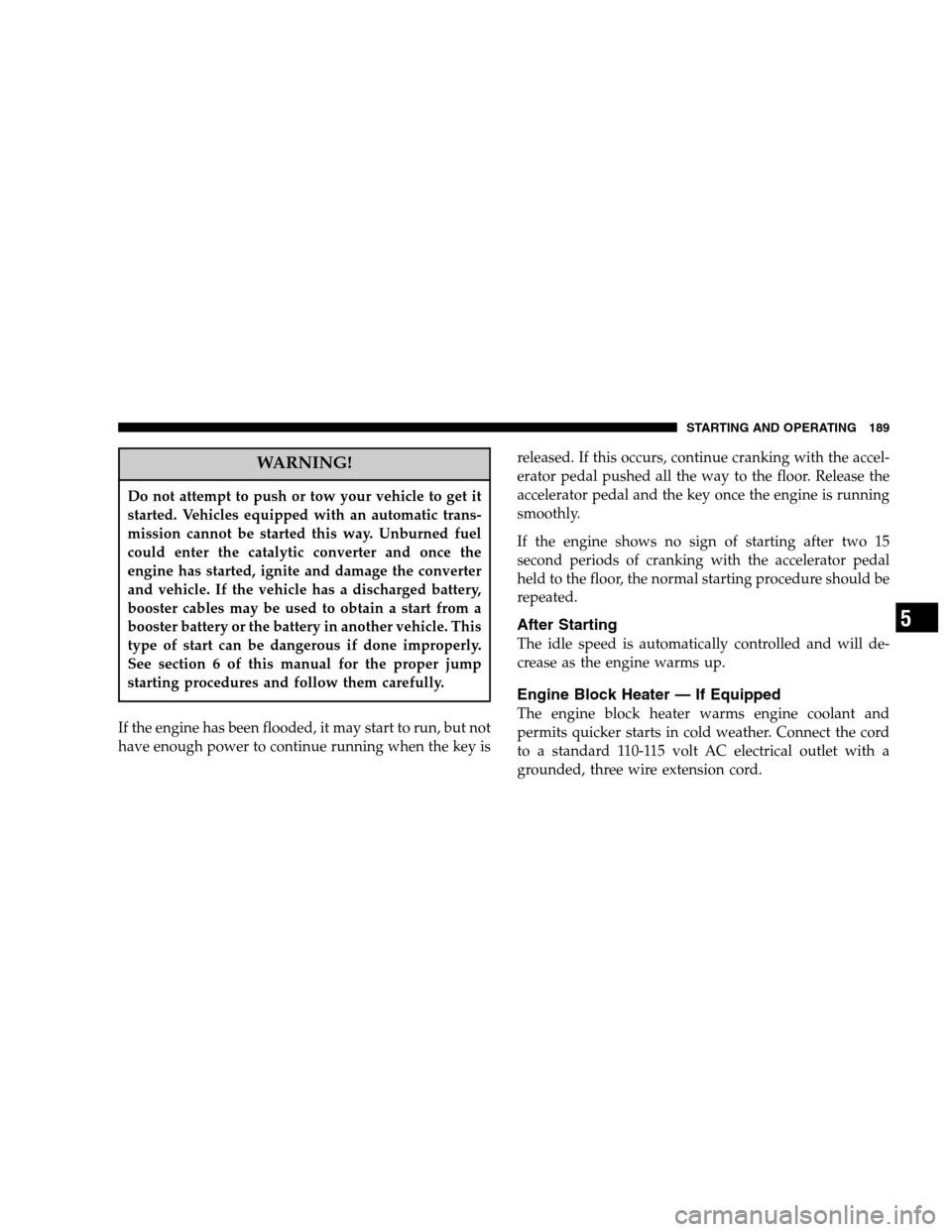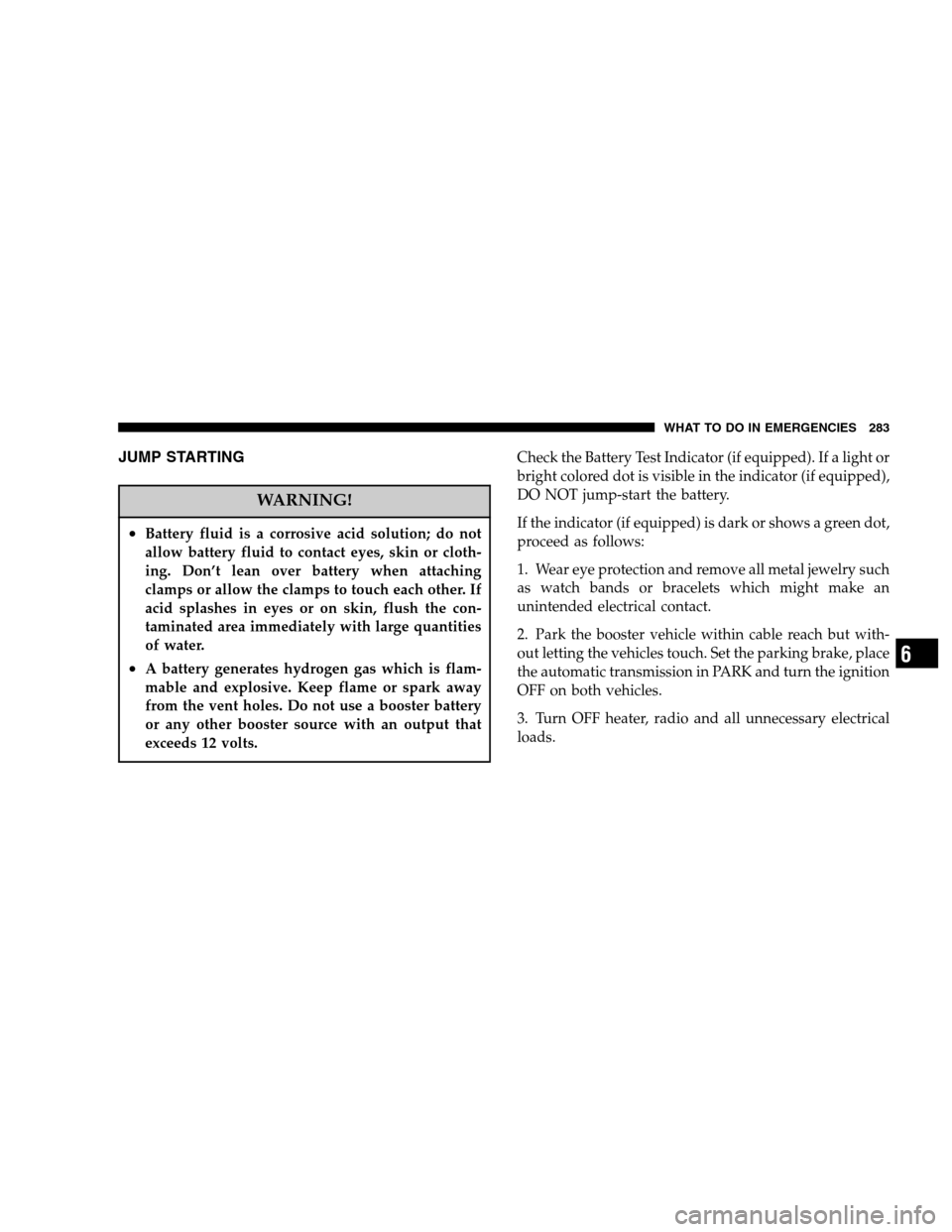Page 189 of 400

WARNING!
Do not attempt to push or tow your vehicle to get it
started. Vehicles equipped with an automatic trans-
mission cannot be started this way. Unburned fuel
could enter the catalytic converter and once the
engine has started, ignite and damage the converter
and vehicle. If the vehicle has a discharged battery,
booster cables may be used to obtain a start from a
booster battery or the battery in another vehicle. This
type of start can be dangerous if done improperly.
See section 6 of this manual for the proper jump
starting procedures and follow them carefully.
If the engine has been flooded, it may start to run, but not
have enough power to continue running when the key isreleased. If this occurs, continue cranking with the accel-
erator pedal pushed all the way to the floor. Release the
accelerator pedal and the key once the engine is running
smoothly.
If the engine shows no sign of starting after two 15
second periods of cranking with the accelerator pedal
held to the floor, the normal starting procedure should be
repeated.
After Starting
The idle speed is automatically controlled and will de-
crease as the engine warms up.
Engine Block Heater — If Equipped
The engine block heater warms engine coolant and
permits quicker starts in cold weather. Connect the cord
to a standard 110-115 volt AC electrical outlet with a
grounded, three wire extension cord.
STARTING AND OPERATING 189
5
Page 271 of 400
WHAT TO DO IN EMERGENCIES
CONTENTS
�Hazard Warning Flasher..................272
�Adding Fuel..........................272
�Changing A Flat Tire....................273
▫Jack Location........................273
▫Removing The Spare Tire................275
▫Tire Changing Procedure................278�Jump Starting.........................283
�Emergency Tow Hooks — If Equipped........285
�Towing A Disabled Vehicle................286
▫Four-Wheel Drive Vehicles...............286
▫Two-Wheel Drive Vehicles...............287
6
Page 283 of 400

JUMP STARTING
WARNING!
•Battery fluid is a corrosive acid solution; do not
allow battery fluid to contact eyes, skin or cloth-
ing. Don’t lean over battery when attaching
clamps or allow the clamps to touch each other. If
acid splashes in eyes or on skin, flush the con-
taminated area immediately with large quantities
of water.
•A battery generates hydrogen gas which is flam-
mable and explosive. Keep flame or spark away
from the vent holes. Do not use a booster battery
or any other booster source with an output that
exceeds 12 volts.
Check the Battery Test Indicator (if equipped). If a light or
bright colored dot is visible in the indicator (if equipped),
DO NOT jump-start the battery.
If the indicator (if equipped) is dark or shows a green dot,
proceed as follows:
1. Wear eye protection and remove all metal jewelry such
as watch bands or bracelets which might make an
unintended electrical contact.
2. Park the booster vehicle within cable reach but with-
out letting the vehicles touch. Set the parking brake, place
the automatic transmission in PARK and turn the ignition
OFF on both vehicles.
3. Turn OFF heater, radio and all unnecessary electrical
loads.
WHAT TO DO IN EMERGENCIES 283
6
Page 284 of 400

4. Connect one end of a jumper cable to the positive
terminal of the booster battery. Connect the other end of
the same cable to the positive terminal of the discharged
battery.
WARNING!
Do not permit vehicles to touch each other as this
could establish a ground connection and personal
injury could result.
5. Connect the other cable, first to the negative terminal
of the booster battery and then to the engine of the
vehicle with the discharged battery. Make sure you have
a good contact on the engine.
WARNING!
Do not connect the cable to the negative post of the
discharge battery. The resulting electrical spark
could cause the battery to explode.
During cold weather when temperatures are below
freezing point, electrolyte in a discharged battery
may freeze. Do not attempt jump starting because
the battery could rupture or explode. The battery
temperature must be brought up above freezing
point before attempting jump start.
6. Start the engine in the vehicle which has the booster
battery, let the engine idle a few minutes, then start the
engine in the vehicle with the discharged battery.
7. When removing the jumper cables, reverse the above
sequence exactly. Be careful of the moving belts and fan.
284 WHAT TO DO IN EMERGENCIES
Page 382 of 400

Emission Related Components.............. 315
Engine
Air Cleaner.......................... 302
Block Heater......................... 189
Break-In Recommendations................ 71
Coolant (Antifreeze).................... 346
Exhaust Gas Caution.................. 72,242
Flooded, Starting...................... 188
Fuel Requirements..................... 345
Jump Starting......................... 283
Oil ...........................297,345,346
Oil Filler Cap......................... 299
Oil Selection.......................... 345
Oil Synthetic......................... 300
Starting............................. 187
Temperature Gauge..................... 136
Entry System, Illuminated.................. 19
Equipment Identification Plate.............. 270
Event Data Recorder...................... 56Exhaust Gas Caution................ 72,242,309
Exhaust System....................... 72,309
Extender, Seat Belt........................ 43
ExteriorLighting ......................... 92
Fabric Care............................ 325
Filters
Air Cleaner.......................... 302
Engine Fuel.......................... 302
Engine Oil........................300,346
Engine Oil Disposal.................... 300
Flashers
Hazard Warning....................... 272
Turn Signal...................... 94,136,338
Flat Tire Stowage........................ 282
Flexible Fuel Vehicles
Cruising Range........................ 247
Engine Oil........................... 246
Fuel Requirements..................... 245
382 INDEX
Page 391 of 400

Speed Control (Cruise Control)............... 99
Speedometer........................... 138
Starting............................... 187
Emergency (Jump Starting)............... 283
Engine Block Heater.................... 189
Engine Fails to Start.................... 188
Remote.............................. 26
Steering
Column Controls....................... 94
Power...........................216,306
Wheel Lock........................... 15
Wheel, Tilt............................ 98
Steering Wheel Mounted Sound System Controls . 172
Storage Compartment, Center Seat........... 122
Storage, Vehicle......................... 332
Stuck, Freeing.......................... 217
Sun Roof.............................. 116
Sunroof Maintenance..................... 119
Supplemental Tire Pressure Information........ 235Synthetic Engine Oil...................... 300
System, Remote Starting.................... 26
Tachometer............................ 139
Tailgate............................... 125
Taillights.............................. 338
Temperature Gauge, Engine Coolant.......... 136
Tether Anchor, Child Restraint............... 61
Theft System Arming...................... 18
Theft System Disarming.................... 18
Tilt Steering Column...................... 98
Tire and Loading Information Placard......222,235
Tire Identification Number (TIN)............. 221
Tire Markings.......................... 218
Tire Safety Information.................... 218
Tires ............................ 73,226,375
Aging(LifeofTires) .................... 233
Air Pressure.......................... 226
Alignment........................... 234
INDEX 391
10